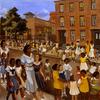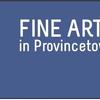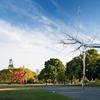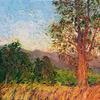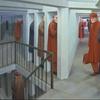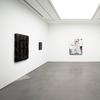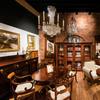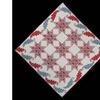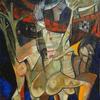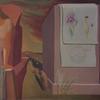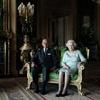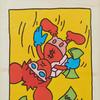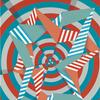'A Cooler, Hipper English Rothko': Seminal Paintings by John Hoyland Shown as Part of Tate Britain’s Spotlights Series
- LONDON, United Kingdom
- /
- August 26, 2019
A display of seminal paintings by John Hoyland is on view now through October 31 as part of the Spotlights series at Tate Britain.
Curated by Andrew Wilson, Senior Curator of Modern and Contemporary Art at Tate Britain, the six major works included are drawn from the Tate’s collection, with the display charting the progression of Hoyland’s work from the late sixties until 2010, the year before his death.
The foremost British Abstract Expressionist of the twentieth century, Sheffield-born Hoyland (1934-2011), is known for his large, colourful and dramatic canvases. He constantly pushed the boundaries of painting with his bold use of colour, inventive forms and ever-evolving sense of what an abstract painting could be. The Tate Collection currently holds forty-two works by Hoyland.
Curator Andrew Wilson has selected paintings from 1969 to 2010, showing the marked difference between Hoyland’s early and late work.The later works become more free-flowing, with a tendency towards thick impasto acrylic paint and varied forms, expanding upon the precision and simplicity of his earlier works.The six paintings show the arc of the artist’s work as it evolved from the huge colour-stained canvases of the 1960s through to the textured surfaces of the 1970s. These are followed by the more spatially complex and improvised paintings of the 1980s and then the semi-figurative work first inspired by the artist’s travels to Bali in the 1990s.
Two of the paintings to be included have recently entered the Tate’s collection, Story From Nature 12.9.96 (1996)and When Time Began (Mysteries 11) 15.11.10 (2010).
Story From Nature is one of Hoyland’s Bali paintings, in which he explored a visionary semi-figuration, inspired by his travels to Bali. Hoyland drew a great deal of inspiration from the Indonesian island in his late career after first visiting in 1994 and returning over several years. It was the first time in decades that he had drawn sustained inspiration from nature. The Bali paintings are some of Hoyland’s most original works. When Time Began (Mysteries II) is an elegiac work from Hoyland’s final series, showing him defiantly contemplating mortality and the infinite.
Hoyland was strongly influenced by his experience of American Abstract Expressionism in the late 1950s and 1960s and knew many of the acclaimed American artists of the time (including Barnett Newman, Mark Rothko, Helen Frankenthaler – in particular Robert Motherwell became a life-long friend). He gained early critical acclaim and went on to win numerous awards, including the prestigious John Moores Painting Prize in 1982. A long-standing and active Royal Academician, he was appointed Professor of Painting at the Royal Academy Schools in 1999.
Although Hoyland himself disliked the term abstraction, finding it smacked too much of geometry and rational thought, he was a life-long proponent of non-figurative imagery, in which he saw “the potential for the most advanced depth of feeling and meaning”. He believed that “...paintings are there to be experienced, they are events.” The works inspired by Bali in the 1990s show his progression in thought, as he became more open to directly evoking the natural world.
Art critic Andrew Lambirth wrote that Hoyland’s paintings were “...abstracts but they are not about absolutes. They are about... very particular emotions, thoughts and feelings dependent upon the act of looking.”
Despite his success, Hoyland often felt like a renegade in the art-world. An early example of this came with his final-year diploma show at the Royal Academy Schools in 1960. Consisting entirely of abstract paintings, it so shocked the RA’s then President Sir Charles Wheeler that it was ordered down from the walls.
Hoyland exhibited with the influential Situation group in 1960-1 and the New Generation artists at the Whitechapel Gallery in 1964. In 1967 he had his first solo museum show at Whitechapel and two years later represented Great Britain at the São Paulo Biennale, Brazil, with sculptor Anthony Caro. His work has since been the subject of retrospectives at the Serpentine Gallery (1979-80), the Royal Academy of Arts, London (1999),Tate St Ives (2006) and was the centrepiece of The Independent Eye exhibition at Yale Center for British Art (2010-11).
Hoyland died in 2011 and a few years after his death the artist was chosen by Damien Hirst as the inaugural exhibition, Power Stations at Hirst’s Newport Street Gallery, which garnered international acclaim.
Hoyland has long been a favourite of many notable figures, with novelist William Boyd writing “Looking at a Hoyland is like looking at a Mark Rothko colour field. Except with an acid edge: Hoyland is like a cooler, hipper English Rothko.”
Damien Hirst has said of Hoyland “...by far the greatest British abstract painter.....In my eyes, John Hoyland was an artist who was never afraid to push the boundaries. His paintings always feel like a massive celebration of life to me.”
The works can be seen at Tate Britain from Monday 26th August 2019 to 31st October 2019. More info on the artist:
The John Hoyland Estate is represented by Pace Gallery.
Contact:
Ella De CleynDamson PR
020 3981 5200
ella.decleyn@damsonpr.com

